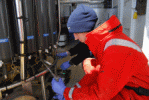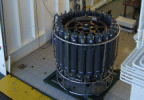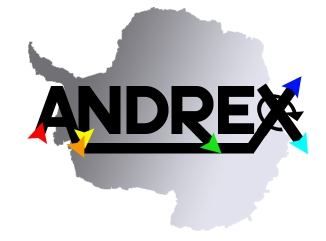CTD
Together, temperature, salinity and pressure determine the density structure of the ocean and as such are of critical interest to physical oceanographers when investigating the circulation and mixing of water masses and transport of freshwater and chemical and biological properties. When an earlier data set for the same region is available, changes in both the physical and chemical characteristics of a water mass can be examined to investigate its recent ventilation, transport and mixing history, and to hopefully infer the key drivers in these processes. For a more detailed description of the processes and instrumentation used on the CTD rosette, please see the excellent dedicated ANDREX blog. For a time-lapse video of CTD sampling on an ANDREX station, click here.



Additionally, continuous underway surveying of the uppermost 800-1000m of the water column was conducted with a shipboard ADCP, providing an independent estimate of on- and between-station upper ocean velocities for comparison with LADCP and geostrophic velocity profiles, respectively.
At each station, the rosette - with bottles set open - is typically lowered from the surface down to ~ 10 m of the ocean floor. On being raised back towards the ship, the bottles are periodically closed at different depths in order to obtain a full depth vertical profile of the water column. Sampling depths are chosen in order to resolve - as well as possible - the characteristics of the different water masses and oceanographic features present in the region under investigation. Water samples are then collected from each Niskin once back on deck by chemists, physicists and biologists for analysis on board, or stored for land-based analysis.
The CTD / LADCP provides continuous profiles of temperature, salinity, oxygen, pressure and velocity, whereas the bottle samples allow a range of physical and biogeochemical tracers to be measured in situ. Amongst the former, samples were taken for measuring the concentrations of helium isotopes (3He, 4He), tritium, CFCs (CFC-11, CFC-12 and CFC-113) and a novel transient tracer (sulphur hexafluoride, SF6). Amongst the latter, samples were taken to measure for oxygen, nutrients (nitrate, nitrite, phosphate and silica) and carbon system parameters (total CO2 and alkalinity).
On the original ANDREX cruise (Dec 2008-Jan 2009 - JC30), a 24 (20L) Niskin bottle rosette with a CTD (Conductivity - for deriving salinity, Temperature, Depth) and LADCP (Lowered Acoustic Doppler Current Profiler) package was employed to take full depth water samples and make continuous profiles of temperature, salinity, pressure, oxygen and velocity, in addition to chlorophyll and turbidity. Whilst underway, ship-based measurements of surface salinity, temperature, bathymetry and meteorological data were collected.
Video of retrieval of CTD during ANDREX - click to play. Adobe Flash player required - available here









